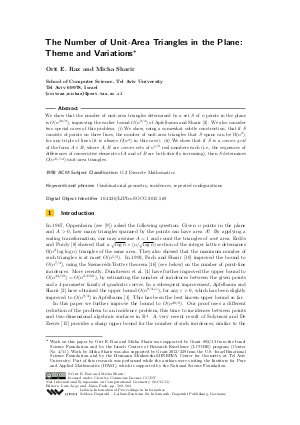The Number of Unit-Area Triangles in the Plane: Theme and Variations
Authors Orit E. Raz, Micha Sharir
-
Part of:
Volume:
31st International Symposium on Computational Geometry (SoCG 2015)
Part of: Series: Leibniz International Proceedings in Informatics (LIPIcs)
Part of: Conference: Symposium on Computational Geometry (SoCG) - License:
 Creative Commons Attribution 3.0 Unported license
Creative Commons Attribution 3.0 Unported license
- Publication Date: 2015-06-12
File

PDF
LIPIcs.SOCG.2015.569.pdf
- Filesize: 0.53 MB
- 15 pages
Document Identifiers
Subject Classification
Keywords
- Combinatorial geometry
- incidences
- repeated configurations
Metrics
- Access Statistics
-
Total Accesses (updated on a weekly basis)
0PDF Downloads0Metadata Views
Abstract
We show that the number of unit-area triangles determined by a set S of n points in the plane is O(n^{20/9}), improving the earlier bound O(n^{9/4}) of Apfelbaum and Sharir. We also consider two special cases of this problem: (i) We show, using a somewhat subtle construction, that if S consists of points on three lines, the number of unit-area triangles that S spans can be Omega(n^2), for any triple of lines (it is always O(n^2) in this case). (ii) We show that if S is a convex grid of the form A x B, where A, B are convex sets of n^{1/2} real numbers each (i.e., the sequences of differences of consecutive elements of A and of B are both strictly increasing), then S determines O(n^{31/14}) unit-area triangles.
Cite As Get BibTex
Orit E. Raz and Micha Sharir. The Number of Unit-Area Triangles in the Plane: Theme and Variations. In 31st International Symposium on Computational Geometry (SoCG 2015). Leibniz International Proceedings in Informatics (LIPIcs), Volume 34, pp. 569-583, Schloss Dagstuhl – Leibniz-Zentrum für Informatik (2015)
https://doi.org/10.4230/LIPIcs.SOCG.2015.569
BibTex
@InProceedings{raz_et_al:LIPIcs.SOCG.2015.569,
author = {Raz, Orit E. and Sharir, Micha},
title = {{The Number of Unit-Area Triangles in the Plane: Theme and Variations}},
booktitle = {31st International Symposium on Computational Geometry (SoCG 2015)},
pages = {569--583},
series = {Leibniz International Proceedings in Informatics (LIPIcs)},
ISBN = {978-3-939897-83-5},
ISSN = {1868-8969},
year = {2015},
volume = {34},
editor = {Arge, Lars and Pach, J\'{a}nos},
publisher = {Schloss Dagstuhl -- Leibniz-Zentrum f{\"u}r Informatik},
address = {Dagstuhl, Germany},
URL = {https://drops.dagstuhl.de/entities/document/10.4230/LIPIcs.SOCG.2015.569},
URN = {urn:nbn:de:0030-drops-51125},
doi = {10.4230/LIPIcs.SOCG.2015.569},
annote = {Keywords: Combinatorial geometry, incidences, repeated configurations}
}
